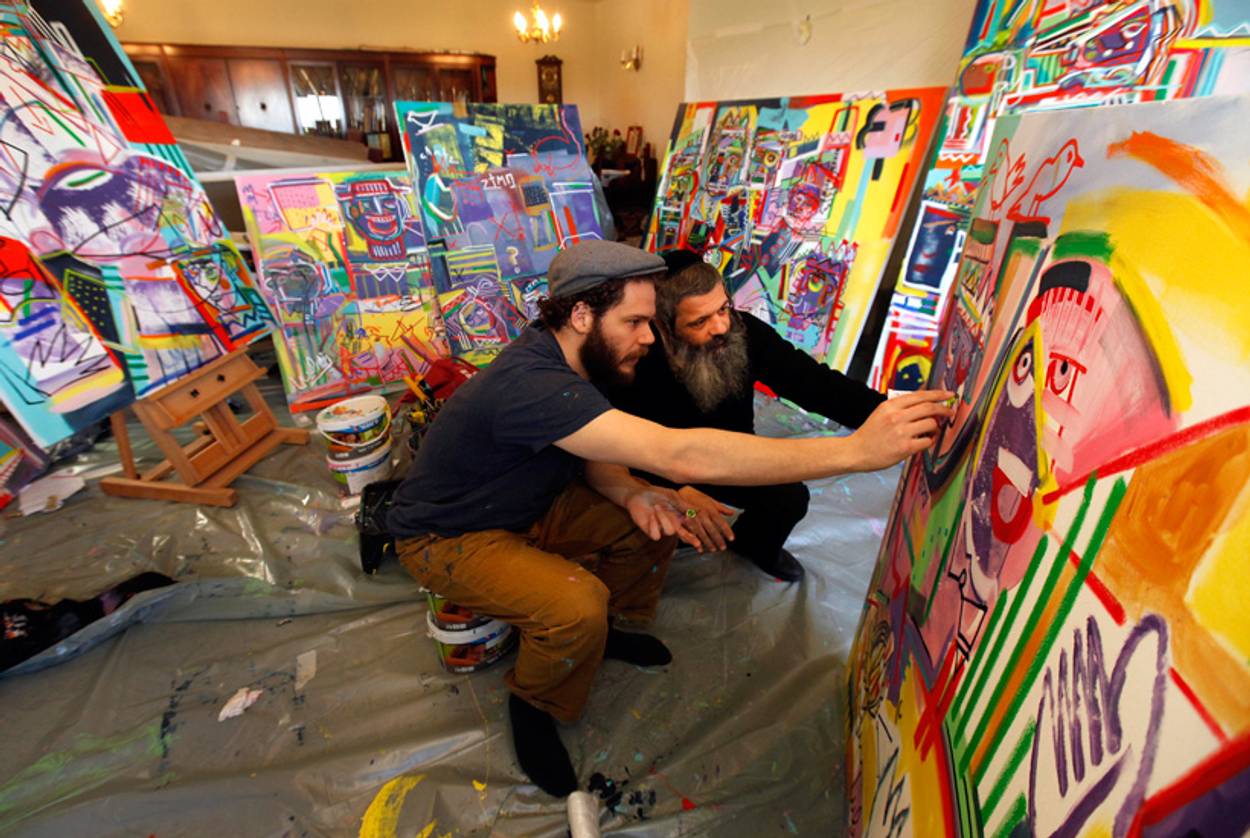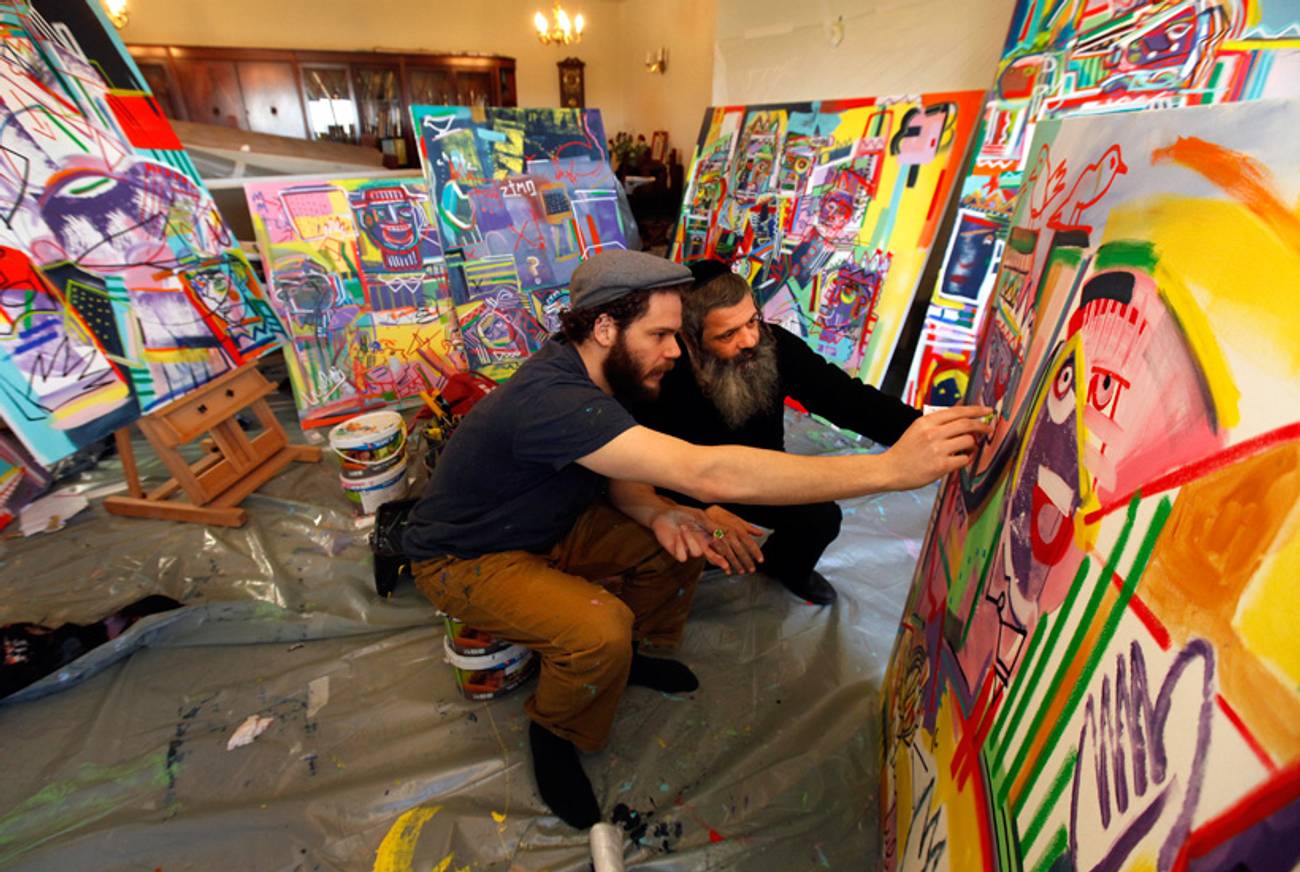Sick of Dancing Hasidim Playing Violins? Meet the New Baal Teshuvah Artists of Brooklyn.
Orthodox Jews new to insular traditions try to integrate the two worlds of strict religion and artistic self-expression




Just a few miles from the central Chabad-Lubavitch community in Crown Heights, fashionably dressed Orthodox men and women in their 20s and 30s mingled in the candle-lit hall of the Roulette Theater last week, tasting wine from the bar and food from waiters’ stations to benefit Lamplighters, the borough’s Chabad Montessori school. The entertainment spotlighted performers who are baal teshuvahs—a small but influential movement of incoming Chabad artists who are reinventing the arts in the Hasidic community. Noah Lubin, a 33-year-old musician, painter, and art teacher living in a Chabad community in Boston, unveiled 15 original paintings that evening inspired by the children of Lamplighters, which has been revolutionizing educational standards in Crown Heights with its focus on art, Montessori materials, and a dual curriculum that integrates Torah and secular subjects. Headlining the show was musical performer Levi Robin, who just completed a 25-city North American tour this year opening for Jewish reggae star Matisyahu. His solo performance at Roulette, the first one since his tour, included an acoustic guitar and original tunes sung with a raspy voice and ethereal sound that held the audience captive for almost an hour.
During an interview after he left the stage, Robin described his music as “simple songs of a simple man,” reflective of an inner journey he took as a 17-year-old after his band that played in Hollywood clubs dismantled. “I looked deep inside myself, and everything changed dramatically,” Robin said. “There’s a direct correlation between my songwriting and becoming religious.” He admitted his poetic songs are not the typical Jewish sound of stars in the Orthodox world, whose music is often based on traditional European melodies, but he added that he “can’t put my finger on anything not Jewish” about the songs. “Being a Jew is an inner experience of growing in this context. I’m trying to tap into my American roots and express my American Jewish journey.” Robin’s performance followed a band (two Hasidic singers and guitarists in the center with a violinist and cellist on either side), led by Hasidic singer Moshe Hecht, whose son attends Lamplighters.
What the evening’s performers bring to the Hasidic world is an understanding and feeling of art that is not trying to be conventionally Jewish. Yet it works both creatively and spiritually because the artists have also been inspired by their new religious life. “Baal teshuvahs are not meant to just fit in and become part of the machine,” said Elad Nehorai, a writer known by his blog name Pop Chassid, during an interview at his apartment home in Crown Heights. He sat at his dining room table with his wife, Rivka, a painter who runs a weekly art group for Hasidic women. The two are baal teshuvahs in their late 20s who organize writers and performances; they attended the same Chabad Hebrew school before their bar and bat mitzvahs and, as teenagers, went to the same public school in their hometown of Highland Park, Chicago. They later reconnected during their college years while independently becoming religious and studying in Israel. On the wall hangs Rivka’s painting of the Holtzberg couple who were killed at their Chabad House in Mumbai in 2008, a painting that was exhibited at a pop art gallery in Crown Heights during the Sukkot holiday last October. The show, which provided opportunities for new Hasidic artists, was organized by Creative Soul, an Orthodox artists’ group of which Rivka is a board member and whose founder, Yitzchok Moully, is an Australian baal teshuvah Hasidic pop artist.
“It’s hard for the frum world to feel comfortable expressing themselves and to make mistakes,” said Nehorai, who published an e-book called 10 Survival Tips for Baal Teshuvas. “As an artist you have to be willing to make public mistakes, you have to take risks, and the vast majority of Hasidic artists are afraid to take the gamble, they have cookie cutter art even when they have the skill. The issue is the polarity, that once a person feels comfortable and expresses themself, the frum from birth psychologically see it as rebellion because it doesn’t fit in.”
***
Yossel Bar-Chaim, a Philadelphia native who studied theater and then became a Chabad Hasid during the late 1980s, experienced culture shock upon arriving in Crown Heights following a period when a mass influx of baal teshuvahs took place in the 1970s through the mid-1980s. In those days, Bar-Chaim explains, there weren’t opportunities for artists to convene. The Lubavitcher Rebbe, Menachem Mendel Schneerson, who lived in Crown Heights, was at the peak of his leadership, and the community’s focus was spiritual gatherings led by the Rebbe during which he taught deep Hasidic discourses, often giving out wine, dollars, or publications to his followers.
As a newly religious Hasid, Bar-Chaim gave up theater and became a Special Education teacher instead. It wasn’t until after the Rebbe’s passing that open-mic events began sprouting up in Crown Heights. In 2003, there were mostly hard-rock guitar jam sessions for teenage boys part of the Aliya Youth Center, which helps troubled Hasidic boys get back on their feet. Their musical open-mics attracted Bar-Chaim, who recalls hearing the then-unknown Matisyahu perform and then took the stage following one of the singer’s beat box, a cappella nigunim (Hasidic melodies). Bar-Chaim was then doing performance art with song poems, spoken-word poetry, and a one-act play with monologs.
“When you experience art that’s true, from a real place, you can’t go back on that,” explained Nehorai’s wife, Rivka. “When you don’t experience that sensation with frum singers you feel something’s wrong. People are responding to Levi Robin because he’s doing something real. He’s trying to integrate two worlds.”
“Creative baal teshuvahs come from a world where they have had access to much more real, personal, moving art,” added Elad. “Most secular artists assume they should share it, but a lot of frum people think if you’re not supposed to share it, you’re not supposed to do it.”
It’s for this reason that both Rivka and Elad have each started groups where sharing any type of content is considered safe and critiqued on its artistic qualities; religious sensitivities are considered if an artist is contemplating exposing it to the outside world. Rivka’s art group begins with yoga and a hired frum model in tight spandex clothing. She says she wants to give Hasidic mothers the space to give to themselves in a creative way. As the group leader, she offers advice, sometimes bringing a quote from Van Gogh or an approach she learned in art school, while maintaining an open, free environment for artists of all levels.
“When a Jewish artist has their head in the right place, the art is a reflection of that,” explained Rivka. While studying Chabad mysticism she discovered how a person’s thoughts affect their emotions and then their actions. “I started to understand art through this perspective. Art will automatically be different, you don’t have to draw the Beit Hamikdash (Jerusalem Temple) for it to be powerful; art will come from that place.”
The artist Noah Lubin, who became religiously observant at age 24, said during an interview at Lamplighters a month ago that he and his wife of two years are a “mish mash” of various Orthodox leanings. He became elusive when defining himself as Hasidic or an artist. “I, in some ways, remain unresolved because I’m always growing and I’m not sure what labels mean,” said Lubin. “Some mornings I wonder whether G-d exists on my way to shul.”
Growing up in a creative home in Chicago and inspired by his mother, an artist, and his father, a poet who also produced reggae music, Lubin began painting five years ago and shyly admits to his international success, calling himself “lucky and privileged.” (His artwork is publicly displayed in Jerusalem’s Old City.) He’s also a “bluesy” Jewish musician who has performed with Matisyahu, produced albums, and appeared at music festivals. “All humans have creativity, and we use it in different ways,” explained Lubin. “We’re creative partners with G-d, it’s part of our inheritance, creativity is a gravitational pull in the world.”
Lubin’s abstract art is mostly concerned with the life he’s familiar with as a baal teshuvah who moved into a traditional, yet modern world. What emerges in visual terms, according to the artist, is urban Judaica, not folklore. “Not everyone is dancing with beards and streimels [Hasidic fur hats],” continued Lubin. Like Robin, Lubin said he’s influenced by a contemporary scene and his secular background. “By painting [reality], I’m not glorifying per se the secular influences but simply communicating them. I want to show what Jewish life looks like today. If you live in Brooklyn, there’s gangs, graffiti, people from all walks of life. It’s not the shtetl in Europe. I’ve never seen Hasidimdancing in fields with violins.”
Thirty-four-year-old Hasidic writer (and contributor to Tablet magazine’s predecessor, Nextbook) Matthue Roth, whose book My First Kafka: Runaways, Rodents, and Giant Bugs was released last week, was at the Lamplighters event since his daughter is a student there. Sporting long, curly sideburns, Roth, who became Orthodox 15 years ago and lives in Ditmas Park, Brooklyn, said during an interview at the close of the evening’s shows that he began performing slam poetry at bars in San Francisco “while keeping Shabbat in a bubble.” He came to New York for Def Poetry Jams on Broadway while hoping to combine both of his identities and landed “by accident,” he said, at the Crown Heights jams 10 years ago. It was the first place where his religion and art overlapped before discovering a baal teshuvah scene in Berkeley, Calif.
“I felt I can do what G-d wants me to do but my other gifts, weird gifts that don’t fit in anywhere, that no one else can do, G-d gave me them for a reason, G-d wants me to do them too,” Roth shared. He said his latest book, which is geared for children, “is a retelling of Kafka’s stories; they’re parables that connect with Hasidic wisdom and Jewish stories.” Another inspiration is one of Kafka’s close friends, Jiri Langer, the Hebrew poet and scholar from Prague who also became a baal teshuvah.
As a working poet, Roth compares his own practice of Orthodox Judaism to writing a sonnet. “A sonnet is very rigid but within those syllables can be anything,” he noted. “Jewish law is strict, what you can and can’t do, but then beyond that our lives can be whatever we want. What rhymes are left to us.”
***
You can help support Tablet’s unique brand of Jewish journalism. Click here to donate today.
Sara Trappler Spielman is a freelance writer in Brooklyn.
Sara Trappler Spielman is a freelance writer in Brooklyn.